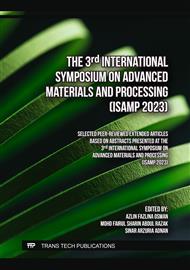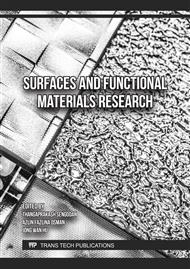p.39
p.59
p.83
p.91
p.97
p.115
p.125
p.133
p.139
The Electrical Performance of Ester-Based Iron Oxide Nanofluids Incorporating Tween 20 Surfactant
Abstract:
Nanoparticles' unique properties, such as their huge surface area, higher thermal conductivity, and increased dielectric strength, make them appealing candidates for high voltage insulation applications. The choice of a suitable surfactant is critical in the creation of nanofluids. The ratio of hydrophilic to lipophilic (HLB) values, which ratio up the hydrophilic and lipophilic structure of the surfactant, is normally considered in the selection of suitable surfactant for the nanofluid. Surfactant with HLB value less than 6 is said to be more suitable for oil base nanofluids. Recent research, however, indicated that the sediment generated by high and low HLB value surfactants is not significantly different. Tween 20 surfactant, while rarely used in this context due to its high HLB value, is an intriguing option due to its affordable cost and excellent properties. Its distinct features, such as low toxicity, and strong emulsification capacity, make it an appealing candidate for stabilizing and dispersing nanoparticles in nanofluid compositions. In this research, tween 20 was used in the preparation of palm oil (PO) and palm fatty acid ester oil (PFAE) based nanofluids. Iron (II,III) Oxide (Fe3O4) nanoparticle was introduced to the nanofluids at high, medium and low concentrations. The nanofluids were evaluated in terms of its breakdown strength and dielectric properties. The alternating current (AC) breakdown and dielectric properties were conducted based on the IEC 60156 and ASTM D924 Standard respectively. Tween 20 has positive impact on shortening down the sonication period by 10 % and 33.3 % for PO and PFAE based nanofluids, respectively, while elongating the sedimentation period for PO nanofluids. The breakdown voltage improved by 40% and 18% for PO based nanofluid and PFAE based nanofluid, respectively. Even at low concentrations, the inclusion of Fe3O4 nanoparticles improved breakdown strength, and breakdown voltage distributions offered useful information. The addition of nanoparticles slightly increases the relative permittivity of the base oils. Fe3O4 nanoparticle and tween 20 surfactant has successfully improved the dielectric loss of the base oil with the lowest value recorded at 0.05 g/L, with 72.4 % and 36.8 % improvement for PO and PFAE based nanofluids, respectively. These results proved that tween 20 is suitable for oil-based nanofluids applications.
Info:
Periodical:
Pages:
115-124
Citation:
Online since:
December 2024
Keywords:
Price:
Сopyright:
© 2024 Trans Tech Publications Ltd. All Rights Reserved
Share:
Citation:



